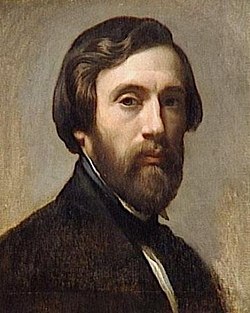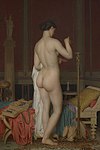Charles Gleyre

Marc Charles Gabriel Gleyre, född 2 maj 1806 i Chevilly, Vaud, död 5 maj 1874 i Paris, var en schweizisk målare inom akademismen.
Gleyre var lärjunge till Louis Hersent och studerade även i Italien. I början av 1830-talet företog han en lång resa till Mellanöstern i följe med en excentrisk och rik ung amerikan och kom ända till Khartoum innan han vände om på grund av sjukdom; under resan gjorde han mängder av teckningar och motiven från denna resa, liksom Bibelns och antikens värld, förblev en del av hans inspiration under resten av livet. Han var verksam som historie- och genremålare, arbetade i en klassicistisk stil och bosatte sig i Paris, där han 1843 övertog Delaroches ateljé. Gleyre undervisade bland andra Bazille, Monet, Renoir, Sisley och Whistler. Trots att han själv var akademisk målare, erkände han dessa unga konstnärers begåvning.
Galleri
- Temple égyptien, 1840
- Le Soir ou Les Illusions perdues, 1843
- La Danse des bacchantes, 1849
- L'Exécution du Major Davel, 1850
- Le Coucher de Sappho, 1867
Källor
- Svensk uppslagsbok, Malmö 1932
Externa länkar
 Wikimedia Commons har media som rör Charles Gleyre.
Wikimedia Commons har media som rör Charles Gleyre.- Charles Gleyre hos Europeana
|
Media som används på denna webbplats
Författare/Upphovsman: Charles Gleyre , Licens: CC BY-SA 4.0
Following in the footsteps of A l'instar de Pentheus, The Dance reveals a new, popularised reading of the roots of ancient Greek civilisation and its forms of worship in the 1830s. Contrary to the solar, masculine and Apollonian vision which had been extolled by Winckelmann since the mid-18th century, Gleyre depicts the primitive, eastern and Dionysian Greece, posited in the works of the philologist and historian Friedrich Creuzer.
Subjects drawn from Antiquity provided the painter with the opportunity for a personal and unusual meditation on the origins of the arts, omitting any reference to either Apollo or Orpheus. In The Dance invented by the Bacchantes, the music played to animals in Minerva, the art of spinning taught to an absurd Hercules by the beautiful Omphale, and the love poetry composed by Sappho - the secret of the arts seems to be the preserve of women, acquired through a mysterious and intuitive affinity with the divine powers of creation.
Execution of major en:Abraham DavelAbraham Davel. Reproduction of a painting by Charles Gleyre. On display at Morges military museum.











